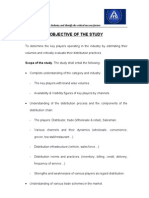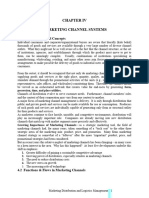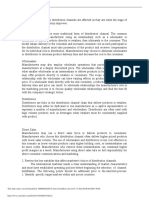Fourteen - Channel Intermediaries: Aims and Objectives of The Chapter
Fourteen - Channel Intermediaries: Aims and Objectives of The Chapter
Uploaded by
Hussain KhawajaCopyright:
Available Formats
Fourteen - Channel Intermediaries: Aims and Objectives of The Chapter
Fourteen - Channel Intermediaries: Aims and Objectives of The Chapter
Uploaded by
Hussain KhawajaOriginal Title
Copyright
Available Formats
Share this document
Did you find this document useful?
Is this content inappropriate?
Copyright:
Available Formats
Fourteen - Channel Intermediaries: Aims and Objectives of The Chapter
Fourteen - Channel Intermediaries: Aims and Objectives of The Chapter
Uploaded by
Hussain KhawajaCopyright:
Available Formats
FOURTEEN - CHANNEL INTERMEDIARIES
__________________________________________________________________________ AIMS AND OBJECTIVES OF THE CHAPTER This chapter aims to make students aware of the roles that intermediaries can perform and of their relative power bases. Channel objectives must be related to the broader marketing mix. Students should be made aware of the economic and social factors which are crucial in managing the organisational relationships necessary to facilitate the flow of products to the end customer. This chapter should provide a sound knowledge of distribution objectives; types of intermediary; selection of intermediaries and methods of motivating and controlling intermediaries. Students should become aware of contemporary developments in marketing channels. The following chapter will return to issues of physical distribution. CHAPTER SYNOPSIS Defining the roles of channel intermediaries Distribution objectives Types of intermediaries Designing a channel of distribution Monitoring and evaluating intermediaries Current trends in intermediaries ANNOTATED LECTURE OUTLINE Point 1 - Channels of distribution are essential for getting products to consumers Most companies would encounter administrative and logistical problems in trying to deliver their goods and services to each of their end-consumers. Instead, companies more often than not use intermediaries to distribute their products. This chapter aims to develop an understanding of the "place" element of the marketing mix and the role of intermediaries in marketing channels. Approaches to designing a channel of distribution and issues in the management and control of intermediaries are discussed. Point 2 - Definition of a channel intermediary A marketing channel has been defined as "a system of relationships existing among businesses that participate in the process of buying and selling products and services". Channel intermediaries are those organisations which facilitate the distribution of goods to
the ultimate customer. The complex roles of intermediaries may include taking physical ownership of products, collecting payment, and offering after-sales service. Marketing channel management refers to the choice and control of these intermediaries. As more and more tasks are passed onto intermediaries, the producing company starts to lose control and power over its products and how they are sold. A key part of channel management therefore involves the recognition that networks of intermediaries represent social systems as well as economic ones. Point 3 - The role of intermediaries in a value chain The generic Value Chain of an organisation describes the activities involved in the manufacture, marketing and delivery of a product or service by the firm (see Figure 14.2, p340). In order to decide whether a firm should undertake its own distribution direct to consumers or whether it would be more efficient and effective to use intermediaries, it is necessary to understand the functions of these intermediaries. Consumers often want only a limited quantity of a wide range of goods, goods that are conveniently made available under one roof (i.e. in a retail supermarket). Intermediaries can help overcome this discrepancy of assortment by reducing dramatically the number of contacts required between suppliers and the end customers (see Figure 14.3, p342). In many cases, intermediaries can have superior knowledge of a target market compared to manufacturers. Retailers can therefore add value to the producers goods by tailoring their offerings more closely to the specific requirements of consumers. Intermediaries help to overcome two types of gap: A location gap occurs due to the geographic separation of producers and the consumers of their goods. A time gap takes place between when consumers want to actually purchase products and when manufactures produce them (e.g. manufacturers may prefer to produce on Monday to Friday, but consumers may prefer to buy at weekends). Intermediaries help to reconcile this gap. Point 4 - Types of intermediary
A variety of types of intermediary can participate in the value chain. Wholesalers and retailers take title to products, typically building up stocks and thereby assuming risk. Other intermediaries such as agents and brokers do not take title to goods. Instead they arrange exchanges between buyers and sellers and in return receive commissions or fees. A number of different types of retailer may be identified: - department stores, e.g. Debenhams. - supermarkets, e.g. Sainsburys. - discount sheds or "category killers", e.g. Toys R Us - speciality shops, e.g. clothing (Next), music (HMV), newsagents (WHSmiths). - convenience or "c" stores, e.g. 7-Eleven - markets and cash and carry warehouses, e.g. Makro. - catalogue showrooms, e.g. Argos. Multiples are usually defined as retailers with over ten outlets. They have tended to grow at the expense of independent retailers, but have also eroded the market share of the cooperatives. Retailers have their own set of strategic choices. Location is usually the most critical issue since it is central to attracting the right kind of customer in sufficient volume to make trade viable. Retailers are using increasingly sophisticated geodemographic methods to determine the optimum locations for their outlets. Strategic decisions need to be made about what product assortment to provide and market segments should be served (Figure 14.6, p347). As East (1997) has pointed out, retailers spend large sums of money in attracting customers, but despite offering factors such as value, choice, friendly service and quality, the main reason cited by supermarket users for patronage is close location. Point 5 - Designing a channel of distribution Channel objectives will be determined by the organisations positioning strategy. The "place" element of the marketing mix must be consistent with the remaining marketing tools used by the marketing manager to gain a sustainable competitive advantage (see Chapter 11). Three options can be identified intensive distribution. Generally used for FMCGs and other relatively low-priced or impulse purchases.
exclusive distribution. Here, distribution may be limited to a small number of intermediaries who gain better margins and exclusivity. selective distribution. This represents a compromise between intensive and selective distribution. The manufacturer is looking for adequate market coverage, but still hopes to select supportive dealers.
There are a number of key influences on channel selection strategies: buyer behaviour (what do customers expect inn terms of location and assortment etc.?), producers needs, (an important constraint is the resources that are available to the manufacturer to bring the product to market. Some companies will lack the finances to recruit and reward a salesforce and so will use a wholesaler instead. product type (e.g. fresh produce that is highly perishable requires fairly short channels) competition (e.g. if competitors have exclusive deals with certain intermediaries, then the support of other channel members with similar marketplace penetration may be sought) A systematic process for design of a channel is important. An "end-user" analysis will result in the creation of an "ideal" channel system which offers a multi-channel format catering for the service level demands of each customer segment. This should be evaluated in terms of the companys objectives and its positioning relative to the competition. A constraints analysis is needed to identify limits which have to be built into any proposed channel structure. Managers can choose from among three generic marketing channels: direct marketing. This involves reaching customers via communications media such as telesales, mailshots, catalogues or advertisements with tear-off reply slips (this is covered in more detail in Chapter 20) salesforce. Here a company might build its own team of salespeople, or perhaps hire an independent contract sales force. Issues of sales management are covered in more detail in Chapter 18. channel intermediary. This alternative is the chief concerned of this chapter. Figure 14.7 (p352) shows some alternative consumer channels. Figure 14.8 (p352) shows alternative channels used in order to reach industrial (organisational) customers. In general, these channels are shorter than those for consumer goods. In the case of services, it is not possible to "own" a service and their delivery cannot be easily separated from the service provider. These factors, and the inability to hold an "inventory" of
unsold services, means that the role of channel intermediary can be very different for services compared to goods. Companies in both consumer and business-to-business markets use a variety of channels to distribute their products. Point 6 - Motivating intermediaries It is frequently necessary to motivate channel members. This is so because of the differing needs of intermediaries and producers: these needs do not necessarily coincide (e.g., a manufacturer may seek exclusive distribution of its products at high prices, whereas a retailer may be pursuing a strategy of market penetration through budget pricing of a wide range of goods). The situation is further complicated by the fact that intermediaries and producers often have different perceptions about their own roles in the supply chain. Doyle suggests two levels of motivator: promotional and partnership. Promotional channel motivators are usually short-term inducements to support the suppliers goods (e.g. trade discounts for large order volumes or providing point-of-sale display materials). Partnership motivators, on the other hand, seek to build a longer-term relationship between suppliers and channel participants (e.g. through sharing of market research information and providing training to a distributors sales staff). Point 7 - Evaluation and control of intermediaries Evaluation of channel performance is necessary to decide which intermediaries to retain and which to motivate, or even, where necessary, to discard. Criteria for evaluation are obviously similar to those used in the initial selection decision (see above). Once the relationship between organisations has been established, criteria can include: the sales volume and value of the producers goods that are generated through the intermediarys outlets, the profitability of servicing that intermediary, the stock levels the intermediary is prepared to hold, the quality of customer service offered, feedback provided about the marketplace and the intermediarys attitude to inter-channel co-operation. However, the scope for evaluation may be severely limited if power lies with the channel member rather than the producer. Point 8 - Power in marketing channels The above leads to a discussion of power in channel relationships. Using power ultimately means getting other channel members to do something they might otherwise not have done. Since members are inter-dependent, the potential for using power lies with all channel
participants. Usually, however, a channel leader emerges. This organisation can derive its power from a number of sources, both economic and non-economic (see figure 14.9, p357). If power is used in a manner believed to be unfair by one or more channel members, then conflict may arise. Conflict need not necessarily be destructive, since it can encourage managers to question the status quo and find ways of improving their distribution systems. Sometimes, however, strategies employed by firms can create unstable, adversarial relationships between producers and intermediaries. A strong focus should be placed by marketing departments on relationship management (see Chapter 8) with channel participants. A possible way forward for manufacturers is Category Management. This is described by Harlow (1995) as "joint strategic planning with retailers to build total category sales and profit for mutual benefit" and is based on the fact that the retailer wishes to maximise the profits from an overall category rather than from a specific brand. A category is seen as a group of products all satisfying the same consumer need, e.g. toothpaste as opposed to, say, Crest. Category management is an advance on the "push" policies of trade marketing (i.e. to the retailer) and provides "pull" by sharing the ownership of brand strategy with the intermediary. Partnerships between producers and intermediaries are also evident in the Efficient Consumer Response (ECR) initiative. ECR involves members of the total supply chain working together to respond to customers purchasing patterns, thereby ensuring the right products are delivered to store shelves on time. There are three types of vertical marketing system: corporate, administered and contractual. The first of these, corporate, is actually increasingly rare since many organisations either cannot afford to, nor wish to, invest in fixed assets or skills where they do not have a competitive advantage (Doyle 1998). Administered systems arise when participants are financially independent but are effectively controlled by the most powerful channel member. In contractual systems channel members rights and obligations are defined by legal agreements. These can include collaborative agreements such as the voluntary chains discussed earlier in this Chapter, where separate firms share resources and agree to joint purchasing initiatives, and franchise arrangements. Point 9 - Franchising Systems
In a franchise system a seller (the franchisor) gives an intermediary (the franchisee) specific services (such as marketing support) and rights to market the sellers product or service within an agreed territory. In return, the franchisee agrees to follow certain procedures and not to buy from unauthorised sellers. The franchisor also typically offers assistance in management and staff training, merchandising and operating systems. This support is usually provided in exchange for a specified fee or royalties on sales from the franchisee. Examples of businesses which are predominantly franchised include McDonalds, Body Shop, Benetton, Tie Rack and Pronuptia. Franchising offers both manufacturer/ retailers and entrepreneurial intermediaries the opportunity to undertake relatively rapid market development at relatively low risk. Consequently, for many internationally operating companies, franchising has become the cornerstone of their global expansion activity. Having said this, problems in controlling standards amongst individual franchisees can occur, e.g. the failure of some of The Body Shops outlets in France. When this takes place, the image of the franchisor can be seriously dented. Point 10 - Global Retailing Chapter 23 explains the importance of global marketing in greater detail, but this chapter briefly discusses the growth of channel intermediaries across national boundaries. Pelligrini suggests that retail companies have three options for growth: vertical integration, retail diversification and internationalisation. Retailing has often been slow to expand globally because of the high level of investment needed to set up in another country, especially when this involves organic growth or risky acquisitions, e.g. the failure of Marks & Spencer to turn around the fortunes of the Brooks Brothers menswear chain in the US. Nevertheless, due to the limited possibilities for growth in national markets, many of the more dynamic retailers have increasingly internationalised their operations. Point 11 - Future channel developments? The McCann-Erickson Research Consultancy (1995) believe that manufacturers need to take a holistic view of distribution, and adopt a new "channel vision" to maximise their opportunities to reach the customer. Figure 14.11 (p364) shows the complex range of channel choices that should be considered by producers of premium branded goods. There are many more options available than merely the traditional retail store.
Thanks to their interactive nature, new channels can give manufacturers the opportunity of reasserting the notion of dialogue with the consumer. New channels may also present smaller producers or innovative retailers with opportunities to enter the marketplace with relative ease, i.e. without the need to find established intermediary partners. Already we have seen the rise of a new type of "middle-man": the infomediary. This intermediary gathers information about customers and uses it on customers behalf to get a better deal of some sort from a supplier. They might screen commercial messages (like a specialised mailing preference service - see Chapter 20) for customers; represent their interests (say, golfing and gardening) to marketers who want access to information about them; and then find vendors who can deliver the best product at the cheapest price (perhaps in the form of a 10% discount offered by the supplier in return for access to the infomediarys client list). If this happens, then the infomediaries become powerful distribution channels in their own right, effectively "selling" customers to marketers. Fanciful perhaps, but certainly food for thought... CASE STUDY DISCUSSION The case study describes how the distribution of music CDs has undergone significant change in recent years as supermarkets have opened up new distribution channels for the music companies. Recent developments in the Internet look set to further dramatically change the way CDs are distributed. Three questions are posed in the text: 1. Identify the key environmental forces that should be considered by CD producers in evaluating strategies for channel design. A useful framework to tackle this question is PEST analysis: Political/legal: Copyright issues - the internet might look attractive as a distribution channel, but what protection does it offer for copyright music? Economic: What is the power of intermediaries relative to music producers? What are the trends in expenditure on music? Social: Is "cyber shopping" going to become normal, or will we still value shopping as a social activity? Technological: The development of the internet opens new possibilities for direct distribution to the home, but consider also technological solutions which may still involve intermediaries, e.g. instant production of CDs at intermediaries premises. 2. Contrast the role of a specialist music retailer with that of a grocery supermarket in the channel for CDs. Comparison should concentrate on
selection offered market segments targeted price position ancillary services offered (e.g. previews) ease of access
3. How would you suggest CD producers might control their marketing channels more effectively? First, ensure that there is a clear understanding of what is meant by "effective" distribution. It should be understood as achieving the highest levels of penetration among the target market for the highest net return for the manufacturer. Consider also strategic issues such as the ability to offer product support and to make available a back catalogue. Control may come about through insisting on minimum stock levels to be held by retailers. Be careful of the word "control", as many activities (e.g. attempts to maintain price levels), may be considered anti-competitive by the Competition Commission.
You might also like
- To Digital Marketing: Study NotesDocument64 pagesTo Digital Marketing: Study NotesJagadish KumarNo ratings yet
- Distribution ChannelsDocument83 pagesDistribution ChannelsMunnangi Nagendrareddy50% (4)
- Chapter 16 Managing Marketing ChannelsDocument9 pagesChapter 16 Managing Marketing ChannelsMandy00011123322No ratings yet
- Distribution Management Chap 1 3Document15 pagesDistribution Management Chap 1 3Shaina Trish Taguiam0% (1)
- Consulting Interview Case Preparation: Frameworks and Practice CasesFrom EverandConsulting Interview Case Preparation: Frameworks and Practice CasesNo ratings yet
- Lowrider - June 2018Document92 pagesLowrider - June 2018Big Flores100% (2)
- Role and Selection and Motivation of IntermediariesDocument5 pagesRole and Selection and Motivation of IntermediariesShivani Tyagi67% (6)
- SDM 4Document15 pagesSDM 4Anonymous 9oL9HS0% (1)
- International MarketingDocument10 pagesInternational MarketingTejal AroraNo ratings yet
- The Importance of Distribution, Types and Types of ConflictDocument8 pagesThe Importance of Distribution, Types and Types of Conflictrohan_jangid8No ratings yet
- MBA202 Marketing Management Unit IVDocument27 pagesMBA202 Marketing Management Unit IVmuskansingh0611No ratings yet
- Distributor, Who Sells To Retailers, Advertisement Typically Used For Consumption GoodsDocument5 pagesDistributor, Who Sells To Retailers, Advertisement Typically Used For Consumption GoodsSonal SaraogiNo ratings yet
- Chapter 9Document42 pagesChapter 9DC M LicyayoNo ratings yet
- Module 5-Distribution MGTDocument21 pagesModule 5-Distribution MGTRevenlie GalapinNo ratings yet
- Place & Distribution by Prof. Rashmi PhirakeDocument45 pagesPlace & Distribution by Prof. Rashmi PhirakeHarshal ShejwalkarNo ratings yet
- MP 10Document8 pagesMP 10Pei Xin YauNo ratings yet
- Report Distribution BiscuitsDocument133 pagesReport Distribution BiscuitsHemant ChopraNo ratings yet
- Assignment MKTDocument52 pagesAssignment MKTbashirgisheNo ratings yet
- Marketing Notes 2-Marketing Channels of DistributionDocument8 pagesMarketing Notes 2-Marketing Channels of DistributionInformation should be FREENo ratings yet
- Distribution - 1Document5 pagesDistribution - 1Durga DeviNo ratings yet
- MM 4th Module NotesDocument20 pagesMM 4th Module NotesRajesh KNo ratings yet
- Principles OF Marketing: Senior High School DepartmentDocument47 pagesPrinciples OF Marketing: Senior High School DepartmentRashamiyya TantosNo ratings yet
- Distribution ChannelsDocument27 pagesDistribution ChannelsBidesh_Chatter_6150100% (2)
- CHAPTER 5 Part IIIDocument5 pagesCHAPTER 5 Part IIIsintebetaNo ratings yet
- SM Chapter 5 Group 1 2Document10 pagesSM Chapter 5 Group 1 2aaronmontefalco440No ratings yet
- Group 7 Selecting Channel PartnersDocument24 pagesGroup 7 Selecting Channel PartnersJillian Salipande AbulenciaNo ratings yet
- Theme 11 Place DistributionDocument9 pagesTheme 11 Place DistributionAleena MirNo ratings yet
- Retailing Encompasses The Business Activities Involved in Selling Goods andDocument3 pagesRetailing Encompasses The Business Activities Involved in Selling Goods andciriaco janNo ratings yet
- Chapter 13 - Designing and Managing Integrated Marketing ChannelsDocument3 pagesChapter 13 - Designing and Managing Integrated Marketing ChannelsHum92reNo ratings yet
- Unit IVDocument2 pagesUnit IVGwapo EpinNo ratings yet
- Designing and Managing Value Networks and ChannelsDocument28 pagesDesigning and Managing Value Networks and ChannelsLyn EscanoNo ratings yet
- Channel Design DecisionsDocument6 pagesChannel Design DecisionsGIFT EDWARD PHIRINo ratings yet
- Module 6Document4 pagesModule 6Janelle BoquidaNo ratings yet
- Pom Chapter SevenDocument13 pagesPom Chapter SevenyetnayettseNo ratings yet
- 18.marketing ChannelsDocument9 pages18.marketing Channelssasithar jaisankaranNo ratings yet
- Prin.-of-Marketing-LAS-11 FinalDocument7 pagesPrin.-of-Marketing-LAS-11 FinalMichael Fernandez ArevaloNo ratings yet
- Channels of DistributionDocument27 pagesChannels of DistributionVinesh KumarNo ratings yet
- Channel of DistributionDocument22 pagesChannel of DistributionLakkhanRobidasNo ratings yet
- Market SegmentationDocument23 pagesMarket SegmentationRahul AroraNo ratings yet
- Unit 4 Distribution ManagementDocument9 pagesUnit 4 Distribution ManagementSusmi SusmithaNo ratings yet
- Chapter 15 Designing and Managing Integrated Marketing ChannelsDocument26 pagesChapter 15 Designing and Managing Integrated Marketing ChannelsrioNo ratings yet
- Distribution System: Pet Shop DetectiveDocument4 pagesDistribution System: Pet Shop DetectiveLaura PovedaNo ratings yet
- Topic 3 Structure of Distribution ChannelsDocument5 pagesTopic 3 Structure of Distribution ChannelschelseaychuuNo ratings yet
- Channel PlanningDocument7 pagesChannel Planningsushil_sagiNo ratings yet
- Principles OF Marketing: Maezel L. Ayson Teacher I 09991719741Document47 pagesPrinciples OF Marketing: Maezel L. Ayson Teacher I 09991719741Rashamiyya TantosNo ratings yet
- Lesson 3 - Channel SelectionDocument14 pagesLesson 3 - Channel Selectionagrawaldinesh20No ratings yet
- Chapter #4Document9 pagesChapter #4Kedir GeletuNo ratings yet
- Channel ManagementDocument7 pagesChannel ManagementViplav NigamNo ratings yet
- Channel Management: Presented By: Sushil Nirbhavane Assistant ProfessorDocument54 pagesChannel Management: Presented By: Sushil Nirbhavane Assistant ProfessorPratik PatilNo ratings yet
- Distribution and Sales Function: Direct ChannelDocument7 pagesDistribution and Sales Function: Direct ChannelFrancisco NavarroNo ratings yet
- Chapter 15Document18 pagesChapter 15RAVI SINGHNo ratings yet
- Im T10Document5 pagesIm T10Ammer Yaser MehetanNo ratings yet
- MKTG QTR 4 Week 3Document8 pagesMKTG QTR 4 Week 3chantrealuna0No ratings yet
- ASSIGNMENT (Marketng) - GOPIKA PDocument10 pagesASSIGNMENT (Marketng) - GOPIKA PAmrutha P RNo ratings yet
- Primar FinalsDocument11 pagesPrimar FinalsMDaenery KlexxxNo ratings yet
- Marketing MixDocument20 pagesMarketing MixrajeevvinodNo ratings yet
- Master of Business Administration ML0006Document11 pagesMaster of Business Administration ML0006sweetsonNo ratings yet
- Mangalayatan University: Distribution ChannelDocument6 pagesMangalayatan University: Distribution ChannelGaurav Singh RajpootNo ratings yet
- Marketing Project - Market SegmentationDocument15 pagesMarketing Project - Market SegmentationSamara Simba Colge100% (1)
- PM CH 8Document5 pagesPM CH 8hamudahmed25No ratings yet
- NIFCODocument6 pagesNIFCOShubhajit NandiNo ratings yet
- Existing Business Model or BOLAVEN FarmDocument3 pagesExisting Business Model or BOLAVEN FarmAsif HasanNo ratings yet
- US B.Inggris 2011-2012Document9 pagesUS B.Inggris 2011-2012YULIANo ratings yet
- HRM in Insurance Sector WRT Recruitment and SelectionDocument57 pagesHRM in Insurance Sector WRT Recruitment and SelectionAnushriAdarshRathiNo ratings yet
- Marketing ManagementDocument10 pagesMarketing ManagementRishi RohanNo ratings yet
- Henko DetergentsgentsDocument14 pagesHenko DetergentsgentsamitsonikNo ratings yet
- Free Enterprise TestDocument4 pagesFree Enterprise TestBongani MaphumuloNo ratings yet
- Visual MerchandisingDocument21 pagesVisual MerchandisingrahulranjanjaiswalNo ratings yet
- Rough M&SDocument36 pagesRough M&Sapplesquash786No ratings yet
- REPHRASING: CONNECTORS 1. 2º BachilleratoDocument2 pagesREPHRASING: CONNECTORS 1. 2º Bachilleratocaracas2020No ratings yet
- Consumer Behavior PDFDocument326 pagesConsumer Behavior PDFganeshitalNo ratings yet
- Russ Dalbey ComplaintDocument33 pagesRuss Dalbey ComplaintMichael_Lee_RobertsNo ratings yet
- SubjectDocument1 pageSubjectFayyaz Bhatti bbNo ratings yet
- Chap6 PDFDocument46 pagesChap6 PDFعبدالله ماجد المطارنهNo ratings yet
- Summary 'The Psychology of Advertising'Document44 pagesSummary 'The Psychology of Advertising'SchmookiddyNo ratings yet
- Screw Worm Gear Gear Axial Force Equation and Calculator - Engineers EdgeDocument4 pagesScrew Worm Gear Gear Axial Force Equation and Calculator - Engineers EdgeManjunath BhatNo ratings yet
- 1stgrading Information Sheet 1.1Document4 pages1stgrading Information Sheet 1.1edward_sheed28No ratings yet
- April 2011 IssueDocument110 pagesApril 2011 IssuePumper MagazineNo ratings yet
- OpenRTB 3.0 Draft Framework For Public CommentDocument36 pagesOpenRTB 3.0 Draft Framework For Public CommentCecilia MarineroNo ratings yet
- Godrej HomeAppliance Case StudyDocument6 pagesGodrej HomeAppliance Case StudySabiha Parveen SalarNo ratings yet
- A Survey Report On: "Marketing Startegies of Pizza Hut & Dominos "Document50 pagesA Survey Report On: "Marketing Startegies of Pizza Hut & Dominos "Riya PandeyNo ratings yet
- Using Emotional Appeals To Reach Customers Case StudyDocument2 pagesUsing Emotional Appeals To Reach Customers Case StudyJanella Reigne TiozonNo ratings yet
- Online Notice Board Project DocumentationDocument6 pagesOnline Notice Board Project DocumentationGm Lakshman100% (5)
- Floyd's 99 v. Chavalo 77 - Floyd's Barbershop Trademark Complaint PDFDocument13 pagesFloyd's 99 v. Chavalo 77 - Floyd's Barbershop Trademark Complaint PDFMark JaffeNo ratings yet
- Disney Targets Redbox Over Resale of Digital Movie CodesDocument19 pagesDisney Targets Redbox Over Resale of Digital Movie CodesGeekWireNo ratings yet
- Advertising Fill in BlanksDocument2 pagesAdvertising Fill in Blankslizazaman55No ratings yet
- Marketing Channels (Retailing) - Chapter 13Document3 pagesMarketing Channels (Retailing) - Chapter 13KaziRafiNo ratings yet
- 07 Ec4t2r PDFDocument24 pages07 Ec4t2r PDFณัฐกรานต์ ไชยหาวงศ์No ratings yet

























































































